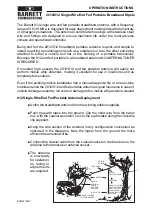
Page 10 of 22
INSTRUCTION MANUAL
AH-8055
HIGH GAIN HORN ANTENNA
1912 1 E l T o ro R d
●
Si l vera do, Ca lifo rni a 9 26 76
●
(9 49) 459 -96 00
●
co m-p o wer. com
REV051517
4.1 Antenna
Factors
Antennas used for EMI tests for frequencies above 30 MHz are typically provided
with electric field antenna factors (AFE). These factors are almost always
provided in logarithmic units in dB per meter (dB/m) or (dB
m-1
), and their values
tend to vary with respect to frequency.
Antenna factor is defined as the “ratio of the electric field in the polarization
direction of the antenna to the voltage induced across the load connected to
the antenna and expressed in decibel form (20 log (E/V
o
)).”
Put more simplistically, the antenna factor represents the difference (in dB)
between:
A)
the voltage present across the output port of the antenna (measured on
an instrument with a 50
Ω
input impedance), and;
B)
the electric field strength (V/m) present at the mid-point of the antenna’s
elements, or in the case of a horn antenna, at the front plane of its
aperture (opening).
As any antenna is less than 100% efficient (without amplification), the voltage
present across the antenna output port will always be less than that present in the
measured field, so the antenna factor can be considered a loss, and is added to
the measured value to obtain the field strength:
Antenna Factor (dB/m)
+
Measured Value (dBμV)
Field Strength (dBμV/m)
=








































